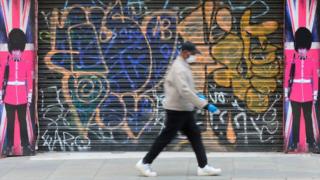 Image copyright
Getty Images
Image copyright
Getty Images
Jobs are being cut around the UK because of the impact of coronavirus.
However, the unemployment rate has remained unchanged. So, what's going on?
How many people are unemployed?
The number of people claiming unemployment benefits surged to 2.7 million between March and July, according to official figures.
However, unemployment is difficult to measure and the picture now is complex.
One measure comes from the Labour Force Survey. This asks thousands of people every month if they are unemployed and looking for work.
It is used to calculate the unemployment rate. At 3.9% it's close to the lowest it has been for 40 years - as if the current crisis never happened.
But in a lockdown, many people who want to look for new jobs are unable or unwilling to. They will be recorded as "inactive" and the number of people in this group rose by 383,000 between March and July.
Many more people told the survey they are employed but are on furlough. This is where people stop working but keep their jobs, and the government pays part of their wages.
The latest figures figures show 7.5m temporarily away from their jobs in June. Furlough comes to an end in October, raising fears that many more people will be out of work if under-pressure employers can't pay them.
And the Office for National Statistics (ONS) identified around half a million workers who say they have a job but are not working or being paid - freelance bar staff, for example, who expect to return to work when their pubs reopen.
How many job vacancies are there?
Other official data shows how coronavirus is beginning to affect the world of work.
The number of employees on UK payrolls fell by 730,000 from March to July. Employment saw the largest falls in a decade, with younger workers, older workers and less skilled workers hit.
Average earnings fell, and the average number of hours people worked dropped by a record amount to an average of 25.8 hours a week, according to figures for April to June.
However there are some signs of things bouncing back. Hours worked in retailing, hospitality and construction rose. And there was a 10% rise in vacancies to 370,000 as small businesses took on staff to help meet coronavirus guidelines.
However, vacancies are still at far lower level than they reached even at the depths of the last recession.
This will have a big effect on future unemployment. Young people will struggle to get their first jobs, and workers who lose their jobs will struggle to find new ones.

How many people are claiming out-of-work benefits?
Over the past three months the number of people claiming out-of-work benefits more than doubled. It reached 2.7 million in July - more than doubling since the crisis began in March.
However, there are question marks over this number.
Benefit claimants are being moved to the new universal credit (UC) system.
Many groups which would not have been included before are listed as "searching for work" under UC and appear in claimant numbers. For instance, some are working, but only earning small amounts.
Also, many workers may have made a UC claim before receiving support payments from the government, including furlough.
According to research from the Resolution Foundation think tank, these groups account for more than a quarter of the rise in claimant numbers. Only 45% of the rise in benefit claimants between March and May was down to newly unemployed people, it calculates.
What will happen to unemployment in the future?
The furlough scheme ends in October - and employers will have to decide if they can afford to keep those workers. That could see a big wave of unemployment in the autumn.
Data from the Insolvency Service showed that employers were planning at least 139,000 redundancies in June. Other companies have since announced big job cuts - but those won't appear in official unemployment numbers for a couple of months at least.
Scenarios published by the government's spending watchdog, the Office for Budget Responsibility, give an official view of what might happen to unemployment.
In its optimistic scenario, the unemployment rate peaks at 9.7% this year, and returns to pre-crisis levels in 2022.
In its "downside" scenario, it peaks at 13.2%, in 2021 - with four million people out of work. It is still at 6.3% by the end of this scenario in 2024 - well above pre-crisis levels.
What questions do you have about unemployment, benefits, what happens next?
In some cases your question will be published, displaying your name, age and location as you provide it, unless you state otherwise. Your contact details will never be published. Please ensure you have read our terms & conditions and privacy policy.
Use this form to ask your question: